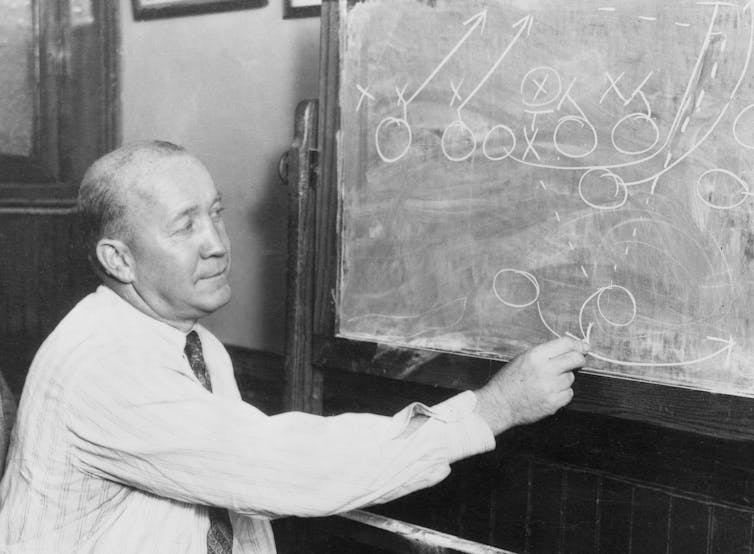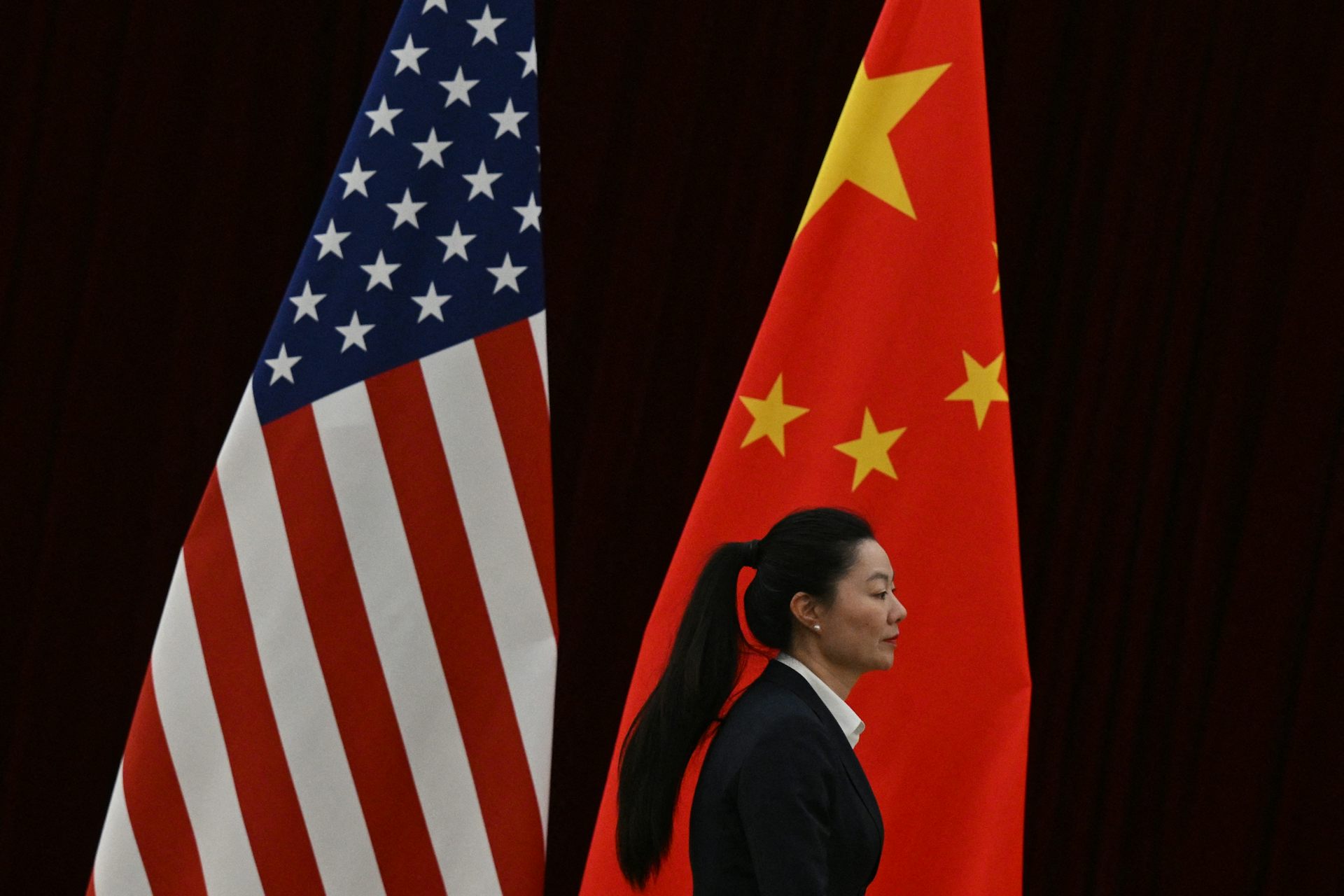Grantland Rice, the Four Horsemen and the blowout that never was
Generations of sportswriters have been inspired by Rice’s penchant for drama and flair. But the spectacular can obfuscate the real, more interesting stories taking place on and off the field.
The Nov. 23, 2024, college football contest between Army and Notre Dame will fittingly take place exactly 100 years after the two storied programs met at New York City’s Polo Grounds – a clash many sports fans recall because of the dramatic column that sportswriter Grantland Rice published the next day.
In his opening paragraph, Rice famously compares the Fighting Irish backfield to the Four Horsemen of the Apocalypse and suggests that the “South Bend cyclone” simply overwhelmed the Army players:
“Outlined against a blue-gray October sky, the Four Horsemen rode again. In dramatic lore they are known as Famine, Pestilence, Destruction and Death. These are only aliases. Their real names are Stuhldreher, Miller, Crowley and Layden. They formed the crest of the South Bend cyclone before which another fighting Army football team was swept over the precipice at the Polo Grounds yesterday afternoon as 55,000 spectators peered down on the bewildering panorama spread on the green plain below.”
Based on this stirring introduction, it might have surprised readers at the time – let alone today’s readers – that Notre Dame did not overwhelm Army.
The game was a 13-7 cliffhanger. After the Notre Dame offense took a 13-0 lead in the third quarter, the Army offense responded with seven points of their own, before failing to take advantage of several opportunities in the fourth quarter to score the winning touchdown.
Of course, that was not the story that Rice wanted to tell.
More than a game
In my 30 years of teaching English and writing courses, I’ve read my fair share of essays that echo Rice’s purple prose. I’ll tell my students that it’s overblown and excessive.
But unlike for most first-year college students, Rice’s style served his purposes well.
Rice honed his craft as a sportswriter in the first two decades of the 1900s, just before the dawn of the period known as the Golden Age of Sports. In the 1920s and 1930s, newspaper circulation expanded rapidly, radio technology brought live sporting events to millions of American homes, and interest in college and professional sports boomed.
As journalism scholars Patrick Washburn and Chris Lamb have explained, before this golden age, many American sports writers sought to boost attendance at sporting events, with some of them even employed by leagues and teams. They also relayed the facts of the boxing matches, horse races and baseball games they were covering – the final score, key moments and top performances.
Rice, who had begun as a reporter for the Nashville Daily News and later became a columnist for the New York Tribune, believed that his job was not so much to recount what had happened in the game, but to instead craft a story that aligned with his vision of how sports ought to be celebrated in American culture.
He believed sports were not just a stage for men and women to demonstrate athletic prowess; he also sought to infuse their performances with biblical drama and turn athletes into contemporary gods. A classics major at Vanderbilt University who often penned original verse in his columns, Rice was the unofficial leader of the Gee Whiz school of sports writing, a group of writers who feted the achievements of athletes while ignoring or even keeping hidden their character flaws.
To Rice, athletes such as Babe Ruth, Jack Dempsey, Red Grange, Bill Tilden and Babe Didrikson Zaharias weren’t everyday people who happened to be good at sports. They were worthy of veneration in American culture itself – key characters in the greatest of dramas playing out on the nation’s fields, courts and racetracks.
Pushing a narrative
It is not hard to imagine a different sort of column for that 1924 game, one that highlighted Army’s grit and perseverance and the heartbreak its players faced at the end as they ran out of gas. That, too, would make a good story and be an easy sell for readers, especially given the military connection.
But Rice did not choose to valorize the tenacity that the Cadets showed in how they had “played the game.” Instead, he focused his column on the storyline of a South Bend cyclone that was too much for any team to handle. It was certainly an effective approach.
Moreover, there may have been another reason Rice sought to amplify Notre Dame’s win. According to sportswriter and critic Mark Inabinett, Rice was friends with Notre Dame coach Knute Rockne, and the victory presented an opportunity to position the Fighting Irish as the best team in the country.

No matter that Notre Dame had won their first two games of the year by much larger margins. Rice used this rather close victory to anoint the Fighting Irish as an unstoppable powerhouse. His column – with an estimated New York readership in the hundreds of thousands and a syndicated readership of about 10 million – was a spectacular opportunity to push the case for the team’s dominance of college football.
When writerly touch goes too far
His column that Sunday morning in the fall of 1924 was just that – spectacular.
It is the embodiment of his approach to sports writing and remains his most well-known work.
His writing style inspired generations of sportswriters that followed him – including Bill Simmons, who, in 2011, named his influential ESPN-owned website Grantland after Rice. It also paved the way for a school of sportswriters to primarily treat games as potential storylines: opportunities to articulate their own notions of sport’s cultural function.
For some writers, that has meant treating a hockey game as a geopolitical standoff. For others, it has meant portraying a Major League Soccer game as a landmark moment for LGBTQ+ people or seeing a tennis match as a lesson in aesthetic pleasure.
These are all well-written stories, and there is nothing inherently wrong with pursuing storylines and constructing certain narratives about games. Sports do serve a cultural function, and it’s the writer’s prerogative to channel their vision.
However, you might wonder what gets lost in a treatment of a game as a means to an end of the writer’s making. The untold narrative might represent a more accurate account of what happened on that field that day.
Even if it was all in a losing effort.
Stephen Brauer does not work for, consult, own shares in or receive funding from any company or organization that would benefit from this article, and has disclosed no relevant affiliations beyond their academic appointment.
Read These Next
Trump’s second term is reshaping US science with unprecedented cuts and destabilizing policy changes
The Trump administration is rewriting the 80-year-old American social contract for science research.
2 superpowers, 1 playbook: Why Chinese and US bureaucrats think and act alike
The men and women tasked with implementing policy are governed by the same incentives and constraints…
Black-market oil buyers will push Venezuela for bigger discounts following US seizure – starving Mad
Venezuela relies on the black-market oil trade for a large chunk of its revenue. US enforcement actions…





